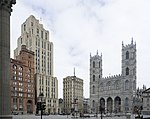Notre-Dame Street

Notre-Dame Street (officially in French: Rue Notre-Dame) is a historic east-west street located in Montreal, Quebec, Canada. It runs parallel to the Saint Lawrence River, from the eastern tip of the island to Lachine.One of the oldest streets in Montreal, Notre-Dame was created in 1672. The gardens of Château Vaudreuil, which had served as the official residence in Montreal of the Governors General of New France from 1723, fronted Notre-Dame. The street's extension in 1821 led to the demolition of Montreal's Citadel. The Bingham house, which became Donegana's Hotel, was also located on Notre-Dame. In the early 1900s, it was the site of the former Dominion Park.
Excerpt from the Wikipedia article Notre-Dame Street (License: CC BY-SA 3.0, Authors, Images).Notre-Dame Street
Rue Notre-Dame Ouest, Montreal Ville-Marie
Geographical coordinates (GPS) Address Nearby Places Show on map
Geographical coordinates (GPS)
| Latitude | Longitude |
|---|---|
| N 45.505704 ° | E -73.556004 ° |
Address
Rue Notre-Dame Ouest 36
H2Y 3Y7 Montreal, Ville-Marie
Quebec, Canada
Open on Google Maps










